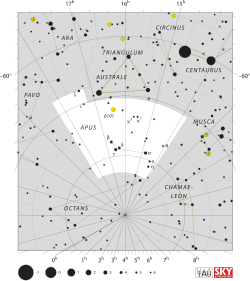HD 138867
| HD 138867 | |
 | |
| Observationsdata Epok: J2000.0 | |
|---|---|
| Stjärnbild | Paradisfågeln |
| Rektascension | 15t 41m 54,68806s[1] |
| Deklination | -76° 04′ 55,0718″[1] |
| Skenbar magnitud () | +5,94 ± 0,01[2] |
| Stjärntyp | |
| Spektraltyp | B9.5 V[3] |
| B–V | -0,03[4] |
| Astrometri | |
| Radialhastighet () | +1,1 ± 1,7[5] km/s |
| Egenrörelse (µ) | RA: -12,407[1] mas/år Dek.: -41,541[1] mas/år |
| Parallax () | 7,8146 ± 0,0916[1] |
| Avstånd | 417 ± 5 lå (128 ± 1 pc) |
| Absolut magnitud () | +0,4[6] |
| Detaljer | |
| Massa | 2,81[7] M☉ |
| Radie | 2,59 ± 0,09[8] R☉ |
| Luminositet | 54,9[9] L☉ |
| Temperatur | 10 375 ± 48[7] K |
| Metallicitet | 0,00[10] |
| Vinkelhastighet | 178 ± 4,3[11] km/s |
| Ålder | 279[10] miljoner år |
| Andra beteckningar | |
| 34 G. Apodis,[12] HD 138867, CPD-75 1222, FK5 3235, GSC 09429-03365, HIC 76877, HIP 76877, HR 5786, 2MASS J15415466-7604552, PPM 372767, SAO 257310, TD1 18371, TYC 9429-3365-1, uvby98 100138867, Gaia DR2 5780285223118104832, Gaia DR3 5780285223118104832, Gaia DR1 5780285218817823104[13][14] | |
HD 138867 eller HR 5786 är en ensam stjärna belägen i den mellersta delen av stjärnbilden Paradisfågeln. Den har en skenbar magnitud av ca 5,94[2] och är svagt synlig för blotta ögat där ljusföroreningar ej förekommer. Baserat på parallax enligt Gaia Data Release 3 på ca 7,81 mas,[1] beräknas den befinna sig på ett avstånd på ca 417 ljusår (128 parsek) från solen. Den rör sig bort från solen med en heliocentrisk radialhastighet på ca 1 km/s.[5]
Egenskaper
[redigera | redigera wikitext]HD 138867 är en blå till vit stjärna i huvudserien av spektralklass B9.5 V[3] med en hög rotation, med en projicerad rotationshastighet på 178 km/s.[11] Den har en massa som är lika med ca 2,8[7] solmassor, en radie som är ca 2,6[8] solradier och utsänder energi från dess fotosfär motsvarande ca 55[9] gånger solen vid en effektiv temperatur av ca 10 400 K.[7]
Det råder oenighet om HD 138867:s mångfald. Chini et al. (2012) listar den som en ensam stjärna[15] medan Eggleton och Tokovinn (2008) fann att den var en astrometrisk dubbelstjärna[16] Det första är mer sannolikt eftersom objektet har en konstant radiell hastighet.
Referenser
[redigera | redigera wikitext]- Den här artikeln är helt eller delvis baserad på material från engelskspråkiga Wikipedia, HD 138867, 10 september 2023.
Noter
[redigera | redigera wikitext]- ^ [a b c d e f] Vallenari, A.; et al. (Gaia collaboration) (2023). "Gaia Data Release 3. Summary of the content and survey properties". Astronomy and Astrophysics. 674: A1. arXiv:2208.00211. Bibcode:2023A&A...674A...1G. doi:10.1051/0004-6361/202243940. S2CID 244398875. Gaia DR3 record for this source at VizieR.
- ^ [a b] Høg, E.; Fabricius, C.; Makarov, V. V.; Urban, S.; Corbin, T.; Wycoff, G.; Bastian, U.; Schwekendiek, P.; Wicenec, A. (March 2000). "The Tycho-2 catalogue of the 2.5 million brightest stars". Astronomy and Astrophysics. 355: L27–L30. Bibcode:2000A&A...355L..27H. ISSN 0004-6361.
- ^ [a b] Abt, Helmut A.; Morrell, Nidia I. (July 1995). "The Relation between Rotational Velocities and Spectral Peculiarities among A-Type Stars". The Astrophysical Journal Supplement Series. 99: 135. Bibcode:1995ApJS...99..135A. doi:10.1086/192182. ISSN 0067-0049.
- ^ https://www.universeguide.com/star/76877/hd138867. Hämtad 2023-12-17.
- ^ [a b] Gontcharov, G. A. (November 2006). "Pulkovo Compilation of Radial Velocities for 35 495 Hipparcos stars in a common system". Astronomy Letters. 32 (11): 759–771. arXiv:1606.08053. Bibcode:2006AstL...32..759G. doi:10.1134/S1063773706110065. eISSN 1562-6873. ISSN 1063-7737. S2CID 119231169.
- ^ Anderson, E.; Francis, Ch. (May 2012). "XHIP: An extended hipparcos compilation". Astronomy Letters. 38 (5): 331–346. arXiv:1108.4971. Bibcode:2012AstL...38..331A. doi:10.1134/S1063773712050015. eISSN 1562-6873. ISSN 1063-7737. S2CID 119257644.
- ^ [a b c d] Zorec, J.; Royer, F. (January 2012). "Rotational velocities of A-type stars. IV. Evolution of rotational velocities". Astronomy and Astrophysics. 537: A120. arXiv:1201.2052. Bibcode:2012A&A...537A.120Z. doi:10.1051/0004-6361/201117691. ISSN 0004-6361. S2CID 55586789.
- ^ [a b] Stassun, Keivan G.; et al. (9 September 2019). "The Revised TESS Input Catalog and Candidate Target List". The Astronomical Journal. 158 (4): 138. arXiv:1905.10694. Bibcode:2019AJ....158..138S. doi:10.3847/1538-3881/ab3467. eISSN 1538-3881.
- ^ [a b] McDonald, I.; Zijlstra, A. A.; Watson, R. A. (15 June 2017). "Fundamental parameters and infrared excesses of Tycho–Gaia stars". Monthly Notices of the Royal Astronomical Society. 471 (1): 770–791. arXiv:1706.02208. Bibcode:2017MNRAS.471..770M. doi:10.1093/mnras/stx1433. eISSN 1365-2966. ISSN 0035-8711.
- ^ [a b] Gontcharov, G. A. (December 2012). "Dependence of kinematics on the age of stars in the solar neighborhood". Astronomy Letters. 38 (12): 771–782. arXiv:1606.08814. Bibcode:2012AstL...38..771G. doi:10.1134/S1063773712120031. ISSN 0320-0108. S2CID 118345778.
- ^ [a b] Levato, H.; Grosso, M. (June 2004). "New Projected Rotational Velocities of All Southern B-type Stars of the Bright Star Catalogue". Astronomical Society of the Pacific. 215: 51. Bibcode:2004IAUS..215...51L.
- ^ Gould, Benjamin Apthorp (1878). "Uranometria Argentina : brillantez y posicion de las estrellas fijas, hasta la septima magnitud, comprendidas dentro de cien grados del polo austral : con atlas". Resultados del Observatorio Nacional Argentino. 1. Bibcode:1879RNAO....1.....G.
- ^ HR 5786 (unistra.fr). Hämtad 2023-12-17.
- ^ "HD 138867". SIMBAD. Centre de données astronomiques de Strasbourg.
- ^ Chini, R.; Hoffmeister, V. H.; Nasseri, A.; Stahl, O.; Zinnecker, H. (10 July 2012). "A spectroscopic survey on the multiplicity of high-mass stars". Monthly Notices of the Royal Astronomical Society. 424 (3): 1925–1929. arXiv:1205.5238. Bibcode:2012MNRAS.424.1925C. doi:10.1111/j.1365-2966.2012.21317.x. ISSN 0035-8711.
- ^ Eggleton, P. P.; Tokovinin, A. A. (11 September 2008). "A catalogue of multiplicity among bright stellar systems". Monthly Notices of the Royal Astronomical Society. 389 (2): 869–879. arXiv:0806.2878. Bibcode:2008MNRAS.389..869E. doi:10.1111/j.1365-2966.2008.13596.x. eISSN 1365-2966. ISSN 0035-8711.
Externa länkar
[redigera | redigera wikitext]
| ||||||||||||||||





